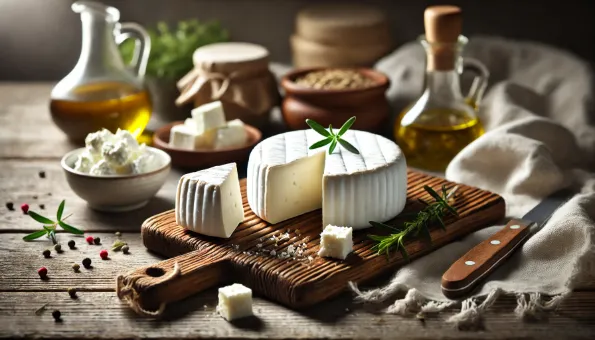Goat Cheese: Tangy, Easy‑to‑Digest Source of Protein & Calcium
At 6 g protein and 90 mg calcium per ounce, goat cheese brings creamy tang and smaller fat globules that many find gentler on digestion than cow’s milk cheese.

What Is Goat Cheese?
Goat cheese (chèvre) is made by coagulating goat’s milk with acid or rennet, then draining and aging from a few days (fresh logs) to several months (bucheron, crottin).
Nutrition (per 1 oz = 28 g)
| | Amount | %DV |
|---|---|---|
| Calories | 103 kcal | — |
| **Protein** | 6 g | 12 % |
| **Total Fat** | 8 g | 10 % |
| – Sat Fat | 5 g | 25 % |
| **Calcium** | 90 mg | 7 % |
| Vitamin A | 200 IU | 4 % |
| Medium‑chain FAs | 15 % of fat | — |
Potential Benefits
- **Smaller fat globules & more MCTs** → often easier to digest.
- Higher **caproic & caprylic acids** may inhibit harmful gut bacteria.
- Rich, tangy flavour means you can use **less cheese** for same taste impact.
- Naturally lower in lactose than fresh cow cheese.
Drawbacks & Precautions
- Still high in saturated fat; portion = 1 oz.
- Fresh goat cheese spoils quickly—watch for pink mould.
- Some people dislike the “barn‑y” aroma; aged styles are milder.
Culinary Uses
- Crumble over beet & walnut salad.
- Whip with honey for cheesecake filling.
- Stuff into dates, roast 8 min for appetiser.
- Melt into polenta for creamy tang.
Storage Tips
Wrap fresh chèvre in parchment + plastic; refrigerate ≤ 7 days. Aged rinds last 3 weeks. Freeze only for cooked dishes—texture becomes crumbly.
Sustainability Notes
Goats thrive on scrub land unsuitable for crops, require less water & feed than cows. Choose local farmstead or pasture‑raised chèvre to cut transport emissions.
Key Takeaways
✔︎ Tangy flavour, easy digestion
✔︎ 6 g protein / oz
✖︎ Keep portions small to limit sat fat.
- 1. Goat Cheese
Goat cheese

